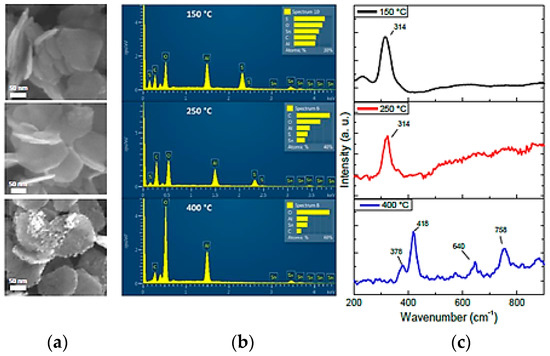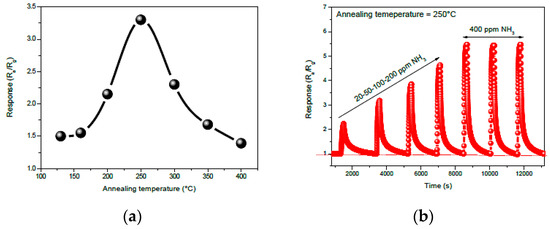Abstract
Hybrid SnS2-SnO2−x flaked nanostructures were obtained from 2D-SnS2 flakes deposited as a thin sensing film onto a conductometric transducing platform and annealed in air. The formation of 2D-SnS2/SnO2−x mixed phases and the materials morphologies were investigated by in situ Micro-Raman spectroscopy and SEM-EDX analysis. As annealing temperature of the sensitive film increases, the response towards ammonia increases showing a maximum at 250 °C. This behavior can be explained on the basis of the morphological modification and the formation of mixed phases.
1. Introduction
In the field of chemoresistive gas sensors, two-dimensional (2D) layered transition metal dichalcogenide are now becoming viable alternatives to metal oxide based sensitive layers due to their peculiarities such as facile synthesis, low band gaps, absence of lattice oxygen and low surface activation energy. These enhanced properties have led to this relatively new category of materials receiving special attention by researchers in this field [1,2,3,4] due to significant improvements in sensing performance, selectivity, stability and energy saving properties. Among them, the tin disulphide (SnS2), a n-type semiconductor with a band gap of 2.18–2.44 eV, has been widely used in the fields of solar cells, photocatalysts, lithium ion batteries, filed effect transistors and biosensors[5,6,7,8]. In particular, the SnS2 is attracting particular interest as a sensitive material for ammonia (NH3) detection due to its unique properties [9,10,11].
In previous works, we demonstrated the excellent sensing performance of 2D SnS2 nanoflakes towards NO2 monitoring and oxygen in dark and under 400 nm UV irradiation [12,13]. In this work, we combine the properties of 2D materials with the advantages of heterostructures, presenting a NH3 sensor based on hybrid SnS2-SnO2−x nanoflakes. The sensing properties of pure SnS2 were investigated and compared with the SnS2-SnO2−x hybrid obtained by a simple self-annealing of the metal sulphide sensitive film directly on the sensor substrate. It was found that the response towards ammonia could be maximized by an optimising annealing treatment parameters of the sensor.
2. Materials and Methods
2.1. Synthesis of SnS2 Nanostructures
The synthesis protocol of 2D SnS2 was adopted from a previous report [12]. Briefly, tin (IV) chloride (SnCl4·5H2O, >99.9%, Sigma-Aldrich, 0.5 mM) was added to a mixture of 5 mL of oleic acid (>90.0%, Sigma-Aldrich) and 10 ml of octadecene (>90.0%, Sigma-Aldrich) in a 100 mL three-neck flask to produce the tin precursor. Then, sulphide powder dispersed in oleylamine (>90.0%, Sigma-Aldrich) was subsequently injected into the reaction system. A standard Schlenk line was used to protect the reaction from oxygen and moisture under a flow of high-purity N2. The reaction was maintained at 280 °C for 30 min. After cooling, the SnS2 powder were collected and separated from the solution by centrifugation. The powder was further washed two times by ethanol and hexane (1/1, v/v) and finally dispersed in ethanol.
2.2. Sensors Preparation and Characterization
The transducers were fabricated on alumina planar substrates (3 mm × 6 mm) with 2 pairs of interdigitated platinum electrodes and an integrated platinum heating element on the back side. Five microliters of suspension containing 1 mg/mL of SnS2 powder was drop-casted on the interdigitated electrodes to form the sensitive layer. The hybrid SnS2-SnO2−x structures were obtained by self-annealing of the sensing films increasing the temperature of the sensor substrates by means of the integrated heater. Therefore, different samples were treated for 10 minutes in the range of temperature 150–400 °C under a constant flux of dry synthetic air (20% O2, 80% N2), in order to form the oxide phase. The sensors were then introduced in a stainless-steel test chamber for the sensing tests which allows carrying out measurements in controlled atmosphere. The material modification as effect of annealing temperature of the sensing film was investigated by in-situ analysis directly on the sensing films casted on the alumina substrates. Raman spectroscopy was carried out by a Craic 20–30 micro-spectrophotometer, under the excitation wavelength of 785 nm at 1 mW power. Morphological analysis was carried out by SEM using a ZEISS 1540XB FE SEM instruments (Zeiss, Germany) equipped with an EDX detector.
3. Results and Discussion
3.1. Characterization
A detailed characterization of the as synthesized SnS2 nanostructure has been previously carried out and it is reported elsewhere [12].
Figure 1a shows the morphologies of 150 °C, 250 °C and 400 °C annealed SnS2 films collected directly on the sensor substrates. All annealed samples show the presence of a homogeneous distribution of 2D hexagonal flakes with ~6–10 nm thickness. Furthermore, almost the same morphology is maintained for 150 °C and 250 °C annealed samples, unlike the sample treated at 400 °C which shows a rough and porous structure.

Figure 1.
Effect of annealing temperature on the morphology and microstructure of 2D SnS2 film. (a) SEM; (b) EDX analysis; (c) Micro-Raman spectroscopy.
The EDX (Figure 1b) and Raman (Figure 1c) spectra confirm the stability of the SnS2 up to 150 °C, whereas the sample annealed at 250 °C shows mixed SnS2-SnO2−x phase and the sample treated at 400 °C can be considered completely transformed to SnO2 phase, as demonstrated by the disappearance of the Raman peak at 314 cm-1 and new specific peaks (main peak at 415 cm−1) formed on the latter sample and related to the full oxidized phase [14].
3.2. Sensing Tests
Figure 2a shows the response to 50 ppm of NH3 obtained at the working temperature of 130 °C in dry air for different sensors treated between 130 °C and 400 °C for 10 min. As it is clearly observable the response increases dramatically starting from the annealing treatment at 200 °C reaching a maximum at 250 °C. For annealing treatments at higher temperature the response continuously decreases until return to values comparable to that of the untreated sample. Figure 2b shows the typical dynamic responses of 250 °C annealed sample when exposed to different concentrations in the range 25–400 ppm of NH3 at the working temperature of 130 °C. The sensor exhibited regular sensing behaviour in the entire range of concentration analysed, showing a decrease of the resistance when exposed to ammonia and fully reversible recovery of the baseline after its removal. Moreover, a good reproducibility of response was observed when it was exposed to consecutive pulses of the same concentration of gas. All the investigated samples showed responses towards ammonia as reduction of electric resistance according to the n-type semiconductor behaviour. However, it worth noting that, similarly to pure SnS2, the 250 °C annealed sample exhibited the highest response and was able to quickly return to the baseline after the ammonia exposure in comparison to SnO2 sample treated at 400 °C. This means that the composition obtained for the hybrid structure SnS2-SnO2−x allows to improve the adsorption kinetics compared to desorption by increasing the response and reducing the response time. The excellent sensitivity observed for 250 °C annealed sample suggests that it can show response at low concentration of ammonia as lower as 1 ppm with high signal to noise ratio.

Figure 2.
(a) Effect of annealing temperature on the response towards 50 ppm NH3 at the working temperature of 130 °C; (b) Dynamic responses of annealed sensing film at 250 °C when exposed to different NH3 concentration in the range 25–400 ppm at the working temperature of 130 °C.
4. Conclusions
Two-dimensional SnS2 flakes deposited as a thin film onto a conductometric transducing platform were annealed in air under controlled conditions at different temperatures up to 400 °C, in order to form sulfide-oxide mixed phases. The 2D morphology of as deposited SnS2 was maintained after the thermal treatments up to 250 °C, whereas modifications of the as-prepared material from SnS2 to SnS2-SnO2−x mixed phases and finally to SnO2 phase were observed. The fabricated conductometric sensors were tested at 130 °C towards NH3 as target gas. Increasing the annealing temperature of the sensitive film the response towards ammonia increased showing a maximum at the annealing temperature of 250 °C. The formation of SnS2/SnO2−x mixed phases combined with the preservation of regular morphology and 2D nanostructure can be considered determining for the improvements of the sensing properties.
Conflicts of Interest
The authors declare no conflict of interest.
References
- Gaiardo, A.; Fabbri, B.; Guidi, V.; Bellutti, P.; Giberti, A.; Gherardi, S.; Vanzetti, L.; Malagù, C.; Zonta, G. Metal sulfides as sensing materials for chemoresistive gas sensors. Sensors 2016, 16, 296. [Google Scholar] [CrossRef] [PubMed]
- Li, X.; Li, X.; Li, Z.; Wang, J.; Zhang, J. WS2 nanoflakes based selective ammonia sensors at room temperature. Sens. Actuators B 2017, 240, 273–277. [Google Scholar] [CrossRef]
- Kuru, C.; Choi, D.; Kargar, A.; Liu, C.H.; Yavuz, S.; Choi, C.; Jin, S.; Bandaru, P.R. High-performance flexible hydrogen sensor made of WS2 nanosheet–Pd nanoparticle composite film. Nanotechnology 2016, 27, 195501. [Google Scholar] [CrossRef] [PubMed]
- Huang, Y.; Guo, J.; Kang, Y.; Ai, Y.; Li, C.M. Two dimensional atomically thin MoS2 nanosheets and their sensing applications. Nanoscale 2015, 7, 19358–19376. [Google Scholar] [CrossRef] [PubMed]
- Yang, Z.; Ren, Y.; Zhang, Y.; Li, J.; Li, H.; Hu, X.H.X.; Xu, Q. Nanoflake-like SnS2 matrix for glucose biosensing based on direct electrochemistry of glucose oxidase. Biosens. Bioelectron. 2011, 26, 4337–4341. [Google Scholar] [CrossRef] [PubMed]
- Lei, Y.; Song, S.; Fan, W.; Xing, Y.; Zhang, H. Facile synthesis and assemblies of flowerlike SnS2 and In3+-doped SnS2: Hierarchical structures and their enhanced photocatalytic property. J. Phys. Chem. C 2009, 113, 1280–1285. [Google Scholar] [CrossRef]
- Giri, D.; Das, K.K. Electronic states of sns and SnS+: A configuration interaction study. J. Phys. Chem. A 2005, 109, 7207–7215. [Google Scholar] [CrossRef] [PubMed]
- Song, H.; Li, S.; Gao, L.; Xu, Y.; Ueno, K.; Tang, J.; Cheng, Y.; Tsukagoshi, K. High-performance top-gated monolayer SnS2 field-effect transistors and their integrated logic circuits. Nanoscale 2013, 5, 9666–9670. [Google Scholar] [CrossRef] [PubMed]
- Chang, H.; In, E.; Kong, K.-J.; Lee, J.-O.; Choi, Y.; Ryu, B.-H. First-principles studies of SnS2 nanotubes: A potential semiconductor nanowire. J. Phys. Chem. B 2005, 109, 30–32. [Google Scholar] [CrossRef] [PubMed]
- Shi, W.; Huo, L.; Wang, H.; Zhang, H.; Yang, J.; Wei, P. Hydrothermal growth and gas sensing property of flower-shaped SnS2 nanostructures. Nanotechnology 2006, 17, 2918. [Google Scholar] [CrossRef]
- Wang, H.; Xu, K.; Zeng, D. Room temperature sensing performance of graphene-like SnS2 towards ammonia. In Proceedings of the SENSORS 2015 IEEE, Busan, Korea, 1–4 November 2015; pp. 1–4. [Google Scholar]
- Ou, J.Z.; Ge, W.; Carey, B.; Daeneke, T.; Rotbart, A.; Shan, W.; Wang, Y.; Fu, Z.; Chrimes, A.F.; Wlodarski, W.; et al. Physisorption-based charge transfer in two-dimensional SnS2 for selective and reversible NO2 gas sensing. ACS Nano 2015, 9, 10313–10323. [Google Scholar] [CrossRef] [PubMed]
- Li, Y.; Leonardi, S.G.; Bonavita, A.; Neri, G.; Wlodarski, W. Two-dimensional (2D) SnS2-based oxygen sensor. Procedia Eng. 2016, 168, 1102–1105. [Google Scholar] [CrossRef]
- Lupan, O.; Chow, L.; Chai, G.; Schulte, A.; Park, S.; Heinrich, H. A rapid hydrothermal synthesis of rutile SnO2 nanowires. Mater. Sci. Eng. B 2009, 157, 101–104. [Google Scholar] [CrossRef]
Publisher’s Note: MDPI stays neutral with regard to jurisdictional claims in published maps and institutional affiliations. |
© 2017 by the authors. Licensee MDPI, Basel, Switzerland. This article is an open access article distributed under the terms and conditions of the Creative Commons Attribution (CC BY) license (https://creativecommons.org/licenses/by/4.0/).